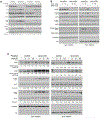Targeting HER3-dependent activation of nuclear AKT improves radiotherapy of non-small cell lung cancer
- PMID: 35839938
- PMCID: PMC10083767
- DOI: 10.1016/j.radonc.2022.07.008
Targeting HER3-dependent activation of nuclear AKT improves radiotherapy of non-small cell lung cancer
Abstract
Background: AKT1 must be present and activated in the nucleus immediately after irradiation to stimulate AKT1-dependent double-strand breaks (DSB) repair through the fast non-homologous end-joining (NHEJ) repair process. We investigated the subcellular distribution of AKT1 and the role of HER family receptor members on the phosphorylation of nuclear AKT and radiation response.
Materials and methods: Using genetic approaches and pharmacological inhibitors, we investigated the subcellular distribution of AKT1 and the role of HER family receptor members on the activation of nuclear AKT in non-small cell lung cancer (NSCLC) cells in vitro. ɤH2AX foci assay was applied to investigate the role of AKT activating signaling pathway on DSB repair. A mouse tumor xenograft model was used to study the impact of discovered signaling pathway activating nuclear AKT on the radiation response of tumors in vivo.
Results: Our data suggests that neither ionizing radiation (IR) nor stimulation with HER family receptor ligands induced rapid nuclear translocation of endogenous AKT1. GFP-tagged exogenous AKT1 translocated to the nucleus under un-irradiated conditions and IR did not stimulate this translocation. Nuclear translocation of GFP-AKT1 was impaired by the AKT inhibitor MK2206 as shown by its accumulation in the cytoplasmic fraction. IR-induced phosphorylation of nuclear AKT was primarily dependent on HER3 expression and tyrosine kinase activation of epidermal growth factor receptor. In line with the role of AKT1 in DSB repair, the HER3 neutralizing antibody patritumab as well as HER3-siRNA diminished DSB repair in vitro. Combination of patritumab with radiotherapy improved the effect of radiotherapy on tumor growth delay in a xenograft model.
Conclusion: IR-induced activation of nuclear AKT occurs inside the nucleus that is mainly dependent on HER3 expression in NSCLC. These findings suggest that targeting HER3 in combination with radiotherapy may provide a logical treatment option for investigation in selected NSCLC patients.
Keywords: DNA repair; HER3; Non-small cell lung cancer; Nuclear AKT; Radioresistance.
Copyright © 2022 Elsevier B.V. All rights reserved.
Conflict of interest statement
Conflicts of interest
All authors declare no competing financial interests.
Figures





Similar articles
-
Targeting of AKT1 enhances radiation toxicity of human tumor cells by inhibiting DNA-PKcs-dependent DNA double-strand break repair.Mol Cancer Ther. 2008 Jul;7(7):1772-81. doi: 10.1158/1535-7163.MCT-07-2200. Mol Cancer Ther. 2008. PMID: 18644989
-
Akt1 Stimulates Homologous Recombination Repair of DNA Double-Strand Breaks in a Rad51-Dependent Manner.Int J Mol Sci. 2017 Nov 20;18(11):2473. doi: 10.3390/ijms18112473. Int J Mol Sci. 2017. PMID: 29156644 Free PMC article.
-
Dual Targeting of Akt and mTORC1 Impairs Repair of DNA Double-Strand Breaks and Increases Radiation Sensitivity of Human Tumor Cells.PLoS One. 2016 May 3;11(5):e0154745. doi: 10.1371/journal.pone.0154745. eCollection 2016. PLoS One. 2016. PMID: 27137757 Free PMC article.
-
Phosphatidylinositol 3-kinase/Akt signaling as a key mediator of tumor cell responsiveness to radiation.Semin Cancer Biol. 2015 Dec;35:180-90. doi: 10.1016/j.semcancer.2015.07.003. Epub 2015 Jul 17. Semin Cancer Biol. 2015. PMID: 26192967 Review.
-
HER3: Toward the Prognostic Significance, Therapeutic Potential, Current Challenges, and Future Therapeutics in Different Types of Cancer.Cells. 2023 Oct 25;12(21):2517. doi: 10.3390/cells12212517. Cells. 2023. PMID: 37947595 Free PMC article. Review.
Cited by
-
Targeting the DNA Damage Response Machinery for Lung Cancer Treatment.Pharmaceuticals (Basel). 2022 Nov 27;15(12):1475. doi: 10.3390/ph15121475. Pharmaceuticals (Basel). 2022. PMID: 36558926 Free PMC article. Review.
-
HER3 Alterations in Cancer and Potential Clinical Implications.Cancers (Basel). 2022 Dec 14;14(24):6174. doi: 10.3390/cancers14246174. Cancers (Basel). 2022. PMID: 36551663 Free PMC article. Review.
-
The Role of PI3K/AKT/mTOR Signaling in Tumor Radioresistance and Advances in Inhibitor Research.Int J Mol Sci. 2025 Jul 17;26(14):6853. doi: 10.3390/ijms26146853. Int J Mol Sci. 2025. PMID: 40725100 Free PMC article. Review.
-
Severe Radiation-Induced Brachial Plexopathy: A Case Report on Radiation Toxicity in a Patient With Invasive Ductal Carcinoma.Cureus. 2024 Nov 5;16(11):e73043. doi: 10.7759/cureus.73043. eCollection 2024 Nov. Cureus. 2024. PMID: 39640102 Free PMC article.
-
Disrupting EGFR-HER2 Transactivation by Pertuzumab in HER2-Positive Cancer: Quantitative Analysis Reveals EGFR Signal Input as Potential Predictor of Therapeutic Outcome.Int J Mol Sci. 2024 May 29;25(11):5978. doi: 10.3390/ijms25115978. Int J Mol Sci. 2024. PMID: 38892166 Free PMC article.
References
-
- Knighton DR, Cadena DL, Zheng J, Ten Eyck LF, Taylor SS, Sowadski JM, et al. Structural features that specify tyrosine kinase activity deduced from homology modeling of the epidermal growth factor receptor. Proc Natl Acad Sci U S A 1993;90:5001–5005. doi:10.1073/pnas.90.11.5001. - DOI - PMC - PubMed
Publication types
MeSH terms
Substances
Grants and funding
LinkOut - more resources
Full Text Sources
Medical
Research Materials
Miscellaneous

